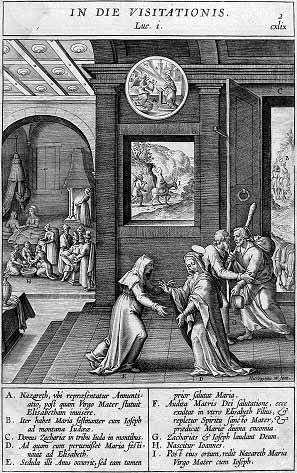
Frans Floris, Frans Floris the Elder or Frans Floris de Vriendt was a Flemish painter, draughtsman, print artist and tapestry designer. He is mainly known for his history paintings, allegorical scenes and portraits. He played an important role in the movement in Northern Renaissance painting referred to as Romanism. The Romanists had typically travelled to Italy to study the works of leading Italian High Renaissance artists such as Michelangelo, Raphael and their followers. Their art assimilated these Italian influences into the Northern painting tradition.

Philip Fruytiers (1610–1666) was a Flemish Baroque painter and engraver. Until the 1960s, he was especially known for his miniature portraits in watercolor and gouache. Since then, several large canvases signed with the monogram PHF have been ascribed to him. These new findings have led to a renewed appreciation for his contribution to the Antwerp Baroque.
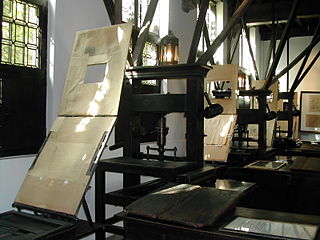
The Plantin Press at Antwerp was one of the focal centers of the fine printed book in the 16th century.

Chrispijn van den Broeck was a Flemish painter, draughtsman, print designer and designer of temporary decorations. He was a scion of a family of artists, which had its origins in Mechelen and later moved to Antwerp. He is known for his religious compositions and portraits as well as his extensive output of designs for prints. He was active in Antwerp which he left for some time because of the prosecution of persons adhering to his religious convictions.
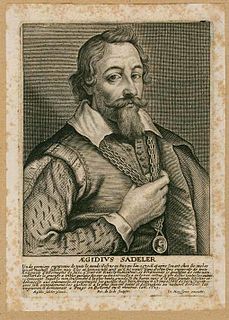
The Sadeler family were the largest, and probably the most successful of the dynasties of Flemish engravers that were dominant in Northern European printmaking in the later 16th and 17th centuries, as both artists and publishers. As with other dynasties such as the Wierixes and Van de Passe family, the style of family members is very similar, and their work often hard to tell apart in the absence of a signature or date, or evidence of location. Altogether at least ten Sadelers worked as engravers, in the Spanish Netherlands, Germany, Italy, Bohemia and Austria.

Stradanus, Johannes Stradanus, Jan van der Straet or Giovanni Stradano was a Flemish artist active mainly in 16th-century Florence, Italy. He was a wide-ranging talent who worked as an easel and fresco painter, designer of tapestries, draughtsman, designer of prints and pottery decorator. His subject range was varied and included history subjects, mythological scenes, allegories, landscapes, genre scenes, portraits, architectural scenes and animals. After training in his native Flanders, he left his home country and ultimately settled down in Florence, Italy. He became a prominent court artist to the Medici during the second half of the 16th century and worked on the many decorative projects of the court. Stradanus also produced large altarpieces for the most important churches in Florence.

PhilipGalle was a Dutch publisher, best known for publishing old master prints, which he also produced as designer and engraver. He is especially known for his reproductive engravings of paintings.

Hieronymus Cock, or Hieronymus Wellens de Cock was a Flemish painter and etcher as well as a publisher and distributor of prints. Cock is regarded as one of the most important print publishers of his time in northern Europe. His publishing house played a key role in the transformation of printmaking from an activity of individual artists and craftsmen into an industry based on division of labour. His house published more than 1,100 prints between 1548 and his death in 1570, a vast number by earlier standards.

Dominicus Lampsonius was a Flemish humanist, poet and painter. A secretary to various Prince-Bishops of Liège, he maintained an extensive correspondence with humanists and artists at home and abroad. His writings on Netherlandish artists formed an important contribution to the formation of the so-called Netherlandish canon.

Maerten de Vos, Maerten de Vos the Elder or Marten de Vos was a Flemish painter. He is known mainly for his history and allegorical paintings and portraits. He was, together with the brothers Ambrosius Francken I and Frans Francken I, one of the leading history painters in the Spanish Netherlands after Frans Floris career slumped in the second half of the sixteenth century as a result of the Iconoclastic fury of the Beeldenstorm.

Hieronymus Wierix (1553–1619) was a Flemish engraver, draughtsman and publisher. He is known for his reproductive engravings after the work of well-known local and foreign artists including Albrecht Dürer. Together with other members of the Wierix family of engravers he played an important role in spreading appreciation for Netherlandish art abroad as well as in creating art that supported the Catholic cause in the Southern Netherlands.

Jan Wierix or Johannes Wierix was a Flemish engraver, draughtsman and publisher. He was a very accomplished engraver who made prints after his own designs as well as designs by local and foreign artists.
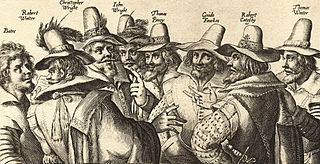
Crispijn van de Passe the Elder, or de Passe was a Dutch publisher and engraver and founder of a dynasty of engravers comparable to the Wierix family and the Sadelers, though mostly at a more mundane commercial level. Most of their engravings were portraits, book title-pages, and the like, with relatively few grander narrative subjects. As with the other dynasties, their style is very similar, and hard to tell apart in the absence of a signature or date, or evidence of location. Many of the family could produce their own designs, and have left drawings.

Jan Baptist Barbé or Jan-Baptist Barbé (1578–1649) was a Flemish engraver, publisher and art dealer active in Antwerp. He is known for his engravings after his own designs as well as for his reproductive engravings.
Thomas de Leu or Leeuw or Le Leup or Deleu (1560–1612) was a French engraver, publisher, and print dealer of Flemish origin.

Hendrik Hondius I was a Flemish-born and trained engraver, cartographer, and publisher who settled in the Dutch Republic in 1597.
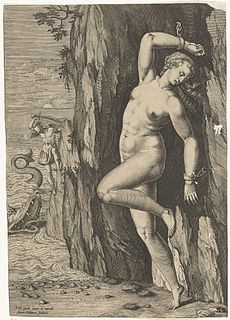
Jan Collaert II or Hans Collaert II was a Flemish engraver and printmaker working in Antwerp around the turn of the 17th century. Collaert also published under the name Jan Baptist Collaert.
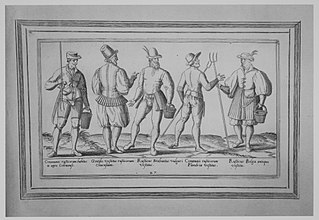
Julius Goltzius was a Flemish printmaker and publisher. He was probably born in Antwerp around 1555 as the son of the painter, printer, publisher and humanist Hubert Goltzius and his wife Elisabeth Verhulst. His mother came from a well-known family of painters and illuminators from Mechelen. Her sister Mayken Verhulst married Pieter Coecke van Aelst and became the mother-in-law of Pieter Bruegel the Elder. Julius Goltzius married in 1587 in Antwerp and probably died in that city well after 1601.

Jacob van Werden or Jacques van Weerden, was a Flemish draughtsman, cartographer, military engineer and archer who was active in the Habsburg Netherlands. His drawings were used as designs for prints executed by various printmakers. He worked on maps, topographical views, historical scenes, portraits and book illustrations. He had a career as a military engineer and a member of the guard of the Spanish King. He advised on various military engineering projects and was an engineer of the army of the Spanish army under Archduke Leopold Wilhelm of Austria at the siege of Landrecies in 1648.

Hendrik van den Keere was a sixteenth-century punchcutter, or engraver of punches to make metal type, who lived in Ghent in modern Belgium.


